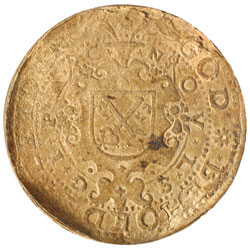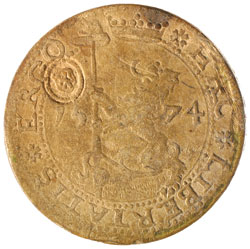World Silver & Bronze Coins


Lot 2960 SESSION 9 (Thursday 11.30am) World Silver & Bronze Coins
Estimate $400
Bid at live.noble.com.au
SOLD $1,100
NETHERLANDS, Leydon, emergency paper issue as coinage, 1574, 20 stuiver 37mm, obv. Crowned lion with liberty cap on pole, legend: "Haec Libertatis Ergo", countermarked at 6.00, rev. legend, "Godt behoede Leyden" arms with crossed keys. (Cf.Del 169). Very fine for issue, very rare coming with an old ticket with a detailed description.
Ex Tom Hanley Collection and previously acquired from Kozminsky, Melbourne September 17, 1906 for 5/-. The siege of the city of Leyden, in modern day Netherlands, is believed to be the first instance wherein paper money of necessity was used. Although Leyden boasts a wide variety of metallic siege coins from the 1570s, it was here that the first paper siege notes were issued. These "notes" are not notes at all but are, more properly, considered coins. When besieged Leyden exhausted its supply of silver, the coins were made of paper torn from prayer books. Resembling the real thing, this money, struck from coin dies, nevertheless was made of paper. Metalic siege money of Leyden was struck in 1574 from a round coin die onto a diamond shaped silver planchet. As the supply of silver available for coinage dried up during the siege, Leyden continued to mint "coins" made from paper torn from prayer books. These cardboard "coins" became the first paper money to appear in the Western world. Prior to this only the Chinese used paper money. A cardboard coin struck during the Spanish siege of Leyden in 1574 has the arms that consist of a rampant lion with shield and sword. The counterstamp is located at six o'clock. By order of Prince William of Orange, provincial counterstamps were added to all coins in excess of 1/10 daalder. This act increased the value of the coinage in circulation by one eighth, which was then used as a war contribution. The Leyden silver siege coins are known to the Dutch as "klippes" or otherwise as "obsidional" coins, an obsidional coin being defined as "a piece of money issued for use during a siege". Interestingly, this definition would seem to cover both metallic and paper issues. There were more than thirty instances during the Dutch War of Liberation, which necessitated the issuance of this type of emergency money. The typical siege coin was struck from coin dies onto square silver planchets. However by the year 1573 the Dutch defenders were running out of funds with which to support their cause. To alleviate this situation and enable continued resistance against the Spanish, the states of Holland and Zeeland raised funds for the war by increasing the value of silver coinage by 1/8th as a war contribution. Commencing in 1573, every coin in excess of 1/10th daalder was counter-stamped by order of William Prince of Orange with an oval coat-of-arms of its respective province. There are claimed to be eight known specimens of Leyden cardboard money made from coinage dies. They range in value from 5 to 30 stuivers. All are dated 1574. Some have countermarks while others do not. A most interesting numismatic item of great rarity.
Estimate / sale price does not include buyer's premium (currently 22% including GST) which is added to hammer price. All bids are executed on the understanding that the Terms & Conditions of sale have been read and accepted. For information on grading and estimates please refer to the Buying at Auction advice.
Quick find
View a lot by number and sale.
Adjacent lots
Lot 2958
MOZAMBIQUE, silver eight reales of Mexico, Potosi mint, 1888 MR, (KM.377.12), countermarked with crowned P ...
Estimate $200
Lot 2959
MOZAMBIQUE, ten centavos 1942 (KM.72), twenty centavos 1950 (KM.75), one escudo 1950 (KM.77), ten escudos ...
Estimate $220
Lot 2960 This lot
NETHERLANDS, Leydon, emergency paper issue as coinage, 1574, 20 stuiver 37mm, obv. Crowned lion with ...
Estimate $400
Lot 2961
NETHERLANDS, under Spain, Albert and Elizabeth, (1598-1621), silver ducatons, 1618 (1) 1619 (2), Antwerp mint, ...
Estimate $200
Lot 2962
NETHERLANDS, under Spain, Albert & Isabelle (1598-1621), silver patagon, Brabant mint, with date 1616 (Del.256, ...
Estimate $200